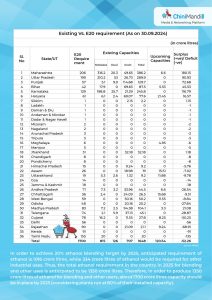From the editor’s desk (Chinimnadi) : Many states surpass ethanol production capacities for E20 requirements, showing enthusiasm for biofuel

India’s Ethanol Blended with Petrol (EBP) Programme is progressing well, with ethanol production capacity reaching 1,648 crore litres by September 2024. States like Maharashtra, Uttar Pradesh, and Karnataka have surplus capacity. Efforts such as the Pradhan Mantri JI-VAN Yojana and the introduction of new crop varieties support this growth, while higher ethanol prices are being considered to maintain momentum.
The Ethanol Blended with Petrol (EBP) Programme has emerged as a transformative initiative for India’s energy landscape, garnering widespread acclaim for its progressive approach. The remarkable growth in ethanol production capacity across the country is a evidence to the faith that producers have placed in this Programme. With many states now exceeding their ethanol capacities, India stands at a key moment in its journey toward a more sustainable energy future.
As part of its commitment to achieving a 20% ethanol blending target by 2025, India requires around 1,350 crore litres of ethanol for both blending and industrial uses. To meet this goal, the production capacity must reach about 1,700 crore litres, assuming plants operate at 80% efficiency. Current figures show that India has already achieved an impressive ethanol production capacity of 1,648 crore litres as of 30th September 2024, with several states boasting surplus capacities.
Let’s take a look at the capacity figures and understand the progress made so far in terms of ethanol production capacities. According to the available data, Maharashtra has a requirement of 206 crore litres for E20, while the existing capacity as of September 30, 2024, is 386.2 crore litres. This indicates that the state has a surplus capacity of 180.15 crore litres. In Uttar Pradesh, the requirement is 199 crore litres, and the state has an overall capacity of 289.9 crore litres, resulting in a surplus of 90.93 crore litres. In Karnataka, the required capacity for E20 is 129 crore litres, while the overall capacity is 245.8 crore litres, reflecting a surplus capacity of 116.79 crore litres. Similarly, many other states in India also have surplus capacities.

There is a noticeable enthusiasm surrounding the expansion of ethanol production, as evidenced by the recent tender offers for the Ethanol Supply Year (ESY) 2024-25. Oil Marketing Companies (OMCs) have called for tenders for 916 crore litres of denatured anhydrous ethanol, and the response has been impressive, with offers surpassing 970 crore litres—more the required amount. OMCs have allocated approximately 837 crore litres of ethanol to producers. This robust response highlights the manufacturers’ commitment, with substantial contributions anticipated from both sugarcane and grain-based feedstocks. However, to sustain this momentum, producers are advocating for a price increase for ethanol. The government is considering this request, recognising that enhanced pricing structures can uplift production and ensure timely payments to farmers. Such measures are crucial for maintaining a steady supply of biofuel and incentivising greater participation in the EBP Programme.
India’s strides toward a 20% ethanol blending target are commendable and signify a commitment to sustainable energy. The government’s proactive measures, including the Pradhan Mantri JI-VAN Yojana, which supports the establishment of Second Generation (2G) bioethanol projects, demonstrate a multifaceted approach to enhancing production capabilities. The recent approval of multiple 2G bioethanol plants signals a significant step forward in utilizing diverse biomass for fuel.
Moreover, the government appears to be making comprehensive efforts to facilitate smooth and uninterrupted ethanol production. Recently, Indian Prime Minister Narendra Modi unveiled 109 crop varieties, which include 4 sugarcane varieties and 6 maize varieties. Each of these new varieties is aimed at tackling specific agricultural challenges and promoting economic benefits. This integrated approach not only supports ethanol production but also benefits farmers and the economy at large.
As discussions regarding the roadmap for ethanol adoption post-2025 gain traction, it is evident that long-term planning is paramount. The substantial investments made in ethanol manufacturing promise to enhance biofuel production, delivering considerable benefits to both farmers and the national economy. The impact of the EBP Programme is already visible, contributing to significant foreign exchange savings and reducing carbon emissions.
As I always keep saying, the future of India’s ethanol industry appears bright, supported by a collaborative spirit between the government and industry stakeholders. By fostering this partnership and refining pricing strategies, India can ensure that its ethanol sector not only meets domestic needs but also lays the groundwork for a sustainable and economically viable energy landscape. In doing so, India can pave the way for a greener future, championing the cause of renewable energy while supporting its agricultural base.

















